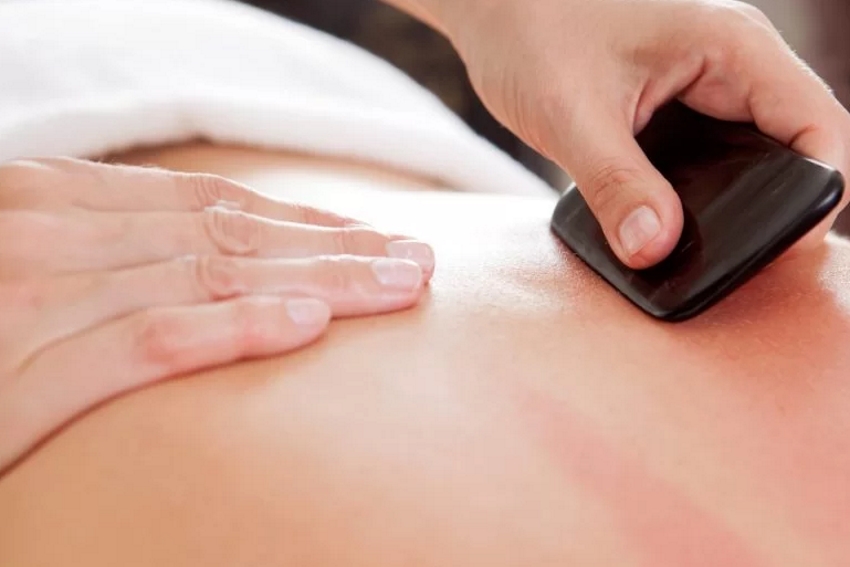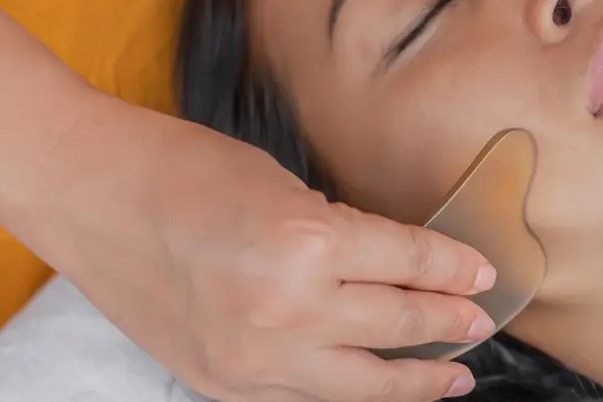
What is gua sha?
Gua sha, also known as “scraping,” is a traditional Chinese healing technique that has been practiced for centuries. The term “gua sha” translates to “scraping sand” in English, which accurately describes the process. It involves using a smooth-edged tool, such as a jade stone or a spoon, to scrape the skin’s surface gently. In the West, more recently, gua sha has gained popularity for its potential health benefits and therapeutic uses.
The theory behind gua sha is rooted in traditional Chinese medicine principles. According to this theory, energy, or “qi,” flows through the body in channels known as meridians. When qi becomes stagnant or blocked, it can lead to pain, inflammation, and illness. Gua sha aims to stimulate the flow of qi and promote healing by scraping the skin and increasing blood circulation to the affected areas.
Traditionally, gua sha has been used to address a wide range of ailments. It is often employed to relieve musculoskeletal pain, such as backaches, neck pain, and joint stiffness. The scraping action of gua sha helps to break up adhesions, release muscle tension, and improve flexibility. Additionally, gua sha is believed to have a detoxifying effect, as it encourages the elimination of toxins through increased circulation and lymphatic drainage.
Beyond its physical benefits, gua sha is also thought to have a positive impact on emotional well-being. Traditional Chinese medicine views emotions as closely tied to the body, and gua sha is believed to help release emotional stagnation. Many practitioners suggest that gua sha can help reduce stress, anxiety, and even promote a sense of overall relaxation and balance.
In recent years, gua sha has gained recognition beyond traditional Chinese medicine circles. It has become popular in the wellness and beauty industry as a natural and non-invasive facial treatment. Gua sha facial massage involves using a smooth-edged tool to scrape the skin gently, helping to improve circulation, reduce puffiness, and promote a healthy glow. Advocates claim that regular gua sha facial treatments can lead to improved skin tone, reduced wrinkles, and a more youthful appearance.
Physiological Effects of Guasha:
Guasha involves scraping the skin with a smooth-edged instrument, such as a spoon or a specialized Guasha tool, to create therapeutic petechiae (tiny red dots) on the skin’s surface. This scraping action stimulates blood flow and causes microcirculation to increase, resulting in several physiological effects.
Increased Circulation: Guasha promotes blood flow, which brings oxygen and nutrients to the treated area, while removing metabolic waste and toxins. Improved circulation can help alleviate pain, reduce inflammation, and support tissue repair.
Release of Tension: The scraping action of Guasha can relax muscles and fascia, reducing muscle tension and promoting flexibility. This can help relieve musculoskeletal pain, such as in cases of muscle strains or trigger points.
Immune System Activation: Guasha stimulates the immune system by increasing the production of white blood cells and enhancing immune response. This can support the body’s ability to fight off infections and strengthen overall immunity.
Anti-Inflammatory Effects: Guasha has been shown to reduce inflammation by inhibiting the release of pro-inflammatory cytokines and promoting the release of anti-inflammatory substances. This effect can be beneficial for conditions involving chronic inflammation, such as arthritis.

History of gua sha:
The roots of Guasha can be traced back to the Stone Age, where primitive tools were used to scrape the body. Archaeological evidence suggests that this technique was employed for various purposes, including healing, pain relief, and even for cosmetic purposes. Over time, the practice evolved and became more refined, with specialized tools crafted from jade, buffalo horns, and other materials.
During the Ming Dynasty (1368-1644) and the Qing Dynasty (1644-1912), Guasha gained recognition as a legitimate medical practice. Scholars and physicians began documenting its therapeutic benefits and incorporating it into traditional Chinese medicine (TCM).
Traditionally, Guasha was used to treat a wide range of ailments, including muscle and joint pain, fever, respiratory conditions, and digestive disorders. The scraping motion stimulates blood circulation, which helps to release toxins, reduce inflammation, and alleviate pain. It is believed that the technique activates the body’s self-healing mechanisms and strengthens the immune system.
Guasha also holds significance beyond its therapeutic benefits. In Chinese culture, it is often practiced within families as a form of self-care and bonding. Parents would use Guasha on their children to prevent and treat illnesses, passing down the knowledge and techniques from one generation to the next. It is a deeply rooted tradition that fosters a sense of community and connection.
Theory of Mechanisms behind Guasha:
From a Western medical perspective, the mechanisms behind Guasha can be explained through several theories and concepts.
Microtrauma and Healing Response: The scraping action of Guasha induces microtrauma to the skin and underlying tissues. This microtrauma triggers a healing response, stimulating the release of growth factors, cytokines, and other biochemicals that promote tissue repair and regeneration.
Neural Modulation: Guasha may affect the nervous system by stimulating sensory nerve endings in the skin. This stimulation can trigger the release of endorphins, which are natural pain-relieving and mood-enhancing substances. Additionally, Guasha may stimulate the autonomic nervous system, balancing its sympathetic and parasympathetic branches, leading to overall relaxation and stress reduction.
Fascial Remodeling: Fascia is a connective tissue that surrounds muscles, organs, and other structures in the body. Guasha can influence fascial remodeling by breaking down adhesions and scar tissue, improving tissue mobility, and enhancing overall function.
Acupoint Stimulation: Guasha often targets specific acupoints, which are areas along meridians believed to regulate the flow of Qi (energy) in traditional Chinese medicine. Western medical theory suggests that stimulating these acupoints may have a direct impact on the nervous system and physiological processes, such as pain modulation and immune system regulation.
